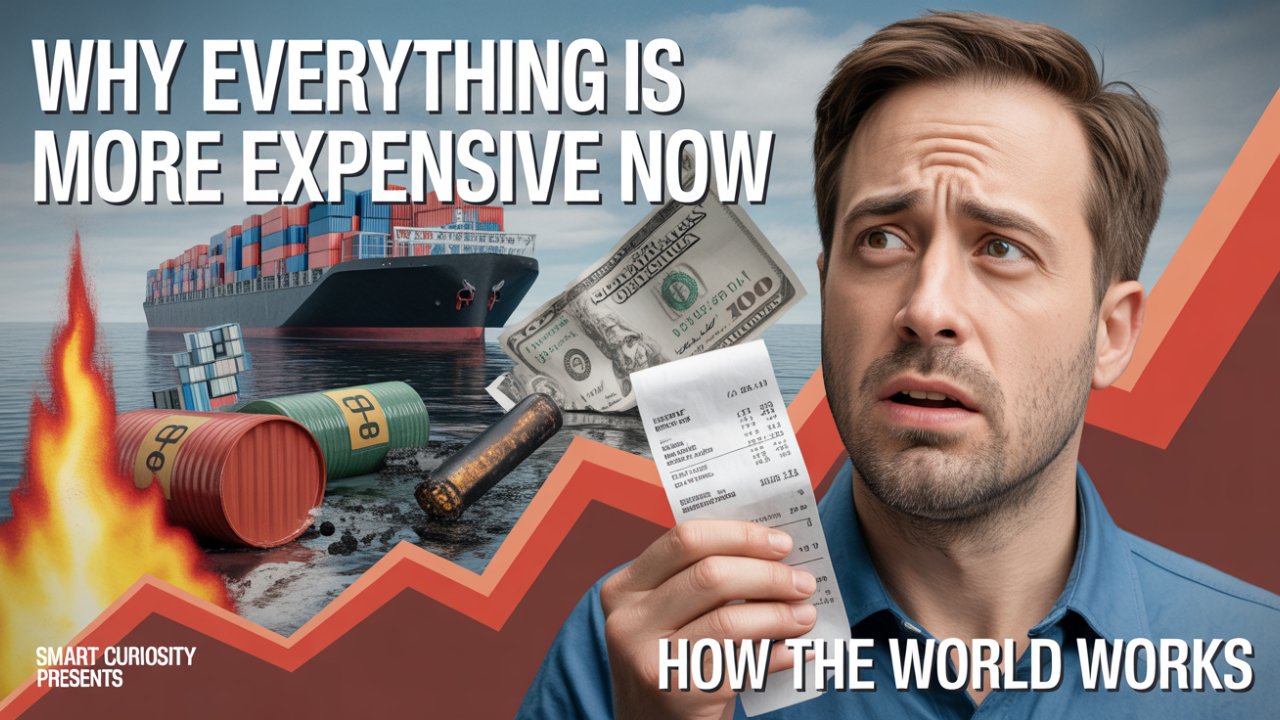Ever get that feeling of sticker shock when you look at your grocery receipt? Or find yourself wincing at the gas pump as the numbers just keep climbing? It’s not in your head, and you’re definitely not alone. It feels like the cost of just existing from food to fuel to the roof over your head is through the roof. Your money just doesn’t go as far as it used to. So many of us feel like we’re working harder than ever, just to watch a rising tide of prices wash away any progress we make. This isn’t just a feeling; it’s the reality for millions of people all over the world.
But what if the real reasons for this have less to do with your local supermarket and more to do with a container ship stuck in a faraway port? Or a war unfolding thousands of miles away? The truth is, we are all caught in the currents of massive, hidden global forces. These are the powerful, interconnected events that lead directly to a lighter wallet for you and me. In this video, we’re going to pull back the curtain. We’ll trace the lines from distant conflicts, broken supply chains, and complex energy politics right to the price tag on your milk, your gas, and your rent. You’re about to see the global game board like never before.
To get why everything costs so much now, we first need to understand the invisible system that, for decades, made everything so cheap. Just think about the device you’re watching this on. Its parts probably came from a dozen different countries. The metals from one continent, the microchips from another, the screen from a third, all assembled in a fourth and shipped to you from a fifth. For a long time, this system was a marvel of efficiency called the “just-in-time” supply chain. Companies didn’t need huge, expensive warehouses packed with parts. Instead, they relied on a perfectly timed global dance, where materials would arrive at the factory just in time to be built into a product, which was then shipped just in time to meet your demand. It was incredibly efficient and incredibly cheap. But it had one giant, hidden flaw: it was unbelievably fragile. It was a long line of dominoes, and in 2020, the first one fell.
The COVID-19 pandemic wasn’t just a health crisis; it was a sledgehammer to that global supply chain. All of a sudden, factories in China making key parts for everything from iPhones to Ford F-150s shut down. The dominoes started to teeter. As the world locked down, the dance just… stopped. But then, something nobody expected happened. People, stuck at home, started buying stuff. A lot of stuff. New office chairs, exercise bikes, video games, you name it. Demand for physical goods exploded, right at the moment our ability to make and ship them had ground to a halt.
This created the perfect storm. The few factories still running couldn’t keep up. And even if they could, getting products to people became a logistical nightmare. The world’s shipping containers the very lifeblood of global trade were suddenly all in the wrong places. They were piled up in American and European ports, but since we weren’t sending much back, the empty containers couldn’t get back to Asia where they were desperately needed. This caused a massive container shortage. The price to ship a single container from Shanghai to Los Angeles shot up, from less than $2,000 before the pandemic to over $20,000 at its peak. And that cost didn’t just vanish it was baked into the price of every single thing in that container.
The gridlock didn’t stop at sea. When ships finally reached their destinations, they were met with record-breaking traffic jams. At the ports of Los Angeles and Long Beach, where nearly half of all goods enter the U.S., dozens of massive ships were forced to idle for weeks, just waiting for a spot to unload. On top of that, dockworkers were out sick, and trucking companies couldn’t find enough drivers. The whole system, once a symbol of seamless flow, became a global picture of total gridlock. This is where the abstract idea of a “supply chain disruption” gets painfully real.
Look at the auto industry. A modern car has about 30,000 parts. The pandemic created a massive shortage of one tiny, cheap part: the semiconductor, or microchip. These chips are a car’s brain, controlling everything from the radio to the brakes. With chip factories shut down or at low capacity, carmakers had to stop their assembly lines. Ford and GM had huge lots filled with nearly-finished cars, just waiting for a few chips. That one bottleneck sent the price of both new and used cars to historic highs. It proves a key point about our economy: the entire system is only as strong as its weakest link.
Even as the pandemic faded, the supply chain never quite healed. New problems kept popping up. Scared by the “just-in-time” model’s fragility, companies started hoarding inventory, a strategy now called “just-in-case.” This created new strains. Then, just as things seemed to be calming down, new crises hit. The war in Ukraine rerouted global shipping, and attacks on ships in the Red Sea forced them to take the much longer, more expensive trip around Africa, adding weeks and millions in fuel costs to each trip. On top of that, political tensions and new tariffs, especially between the U.S. and China, are like a direct tax on imported goods a tax that businesses eventually pass on to you.
So when you see that the price of a bike or a new table has jumped, you’re not just seeing inflation. You’re seeing the ghost of a closed factory, the echo of a ship stuck at sea, and the cost of a war in a distant land. The era of the seamless, invisible supply chain is over. We now live in a world where geography and conflict are, once again, a very visible part of the price of everything.
If the supply chain is the economy’s circulatory system, then energy is the heart that pumps the blood. It’s the most critical commodity, because almost nothing gets made, grown, or moved without it. The price of energy is hidden in the price of everything else. And for the past few years, that heart has been under serious stress.
For most of us, the most direct hit is at the gas station. But the gas in your car is just the start. Think about your food. The journey from farm to table is powered by energy. Tractors run on diesel. The fertilizer that helps crops grow is made using a ton of natural gas. The trucks, trains, and ships that move the food all burn fuel. The factories that package it run on electricity. Even the grocery store’s lights and refrigerators use a massive amount of power. So, when energy prices go up, food prices always follow.
The story of the recent energy crisis starts, like so many other problems, with the pandemic. When the world shut down in 2020, energy demand collapsed. Oil prices famously, for a moment, went negative sellers had to actually pay buyers to take oil because there was nowhere left to store it. In response, energy producers, from OPEC to Texas shale drillers, shut everything down.
But as the world roared back to life in 2021, our demand for energy snapped back way faster than they could turn the pumps back on. Starting an oil rig isn’t like flipping a switch. So you had a huge surge in demand hitting a very limited supply. And basic economics says prices had to go up. Then, that steady climb was supercharged into a full-blown crisis by the Russian invasion of Ukraine in early 2022.
This was a bombshell for energy markets. Russia was a top exporter of oil and the biggest supplier of natural gas to Europe. Western sanctions, meant to punish Russia, had a massive ricochet effect. Europe, which depended on cheap Russian gas, had an existential crisis. It had to frantically buy energy on the global market, competing with Asia and other nations for a limited supply of Liquefied Natural Gas, or LNG.
This kicked off a global bidding war. Natural gas prices in Europe shot to levels nobody thought possible. And because energy markets are global, that shockwave was felt everywhere. You might wonder why a war in Europe made your heating bill in America go up. It’s because U.S. gas producers could now sell their LNG to desperate buyers in Europe for a much higher price. That drove up domestic prices for everyone. It’s the perfect example of how interconnected we are: a pipeline shut off in Siberia can lead directly to a higher electricity bill in Ohio.
Beyond the headlines, there are secretive forces that affect your energy bill. Decisions made by OPEC+, the cartel of oil-producing nations led by Saudi Arabia and including Russia, have a huge impact. When they meet behind closed doors, their choice to cut production can make prices soar, helping their national budgets but acting as a tax on the rest of the world.
And while the global push for green energy is essential, the transition is adding its own costs. We’re in an awkward middle phase. Investment in new solar and wind is massive, but we’ve also underinvested in the old fossil fuel systems. When the wind doesn’t blow or the sun doesn’t shine, we still have to fall back on natural gas power plants to keep the lights on, creating a new kind of volatility.
The energy equation is a tangled web of geology and geopolitics, war and weather. From the plastic in your phone to a plane ticket for vacation, everything is a product of energy. The recent price spikes are a painful reminder that the cost of power is built into the cost of everything.
We’ve covered the physical stuff the products and the energy. But there’s a third, more abstract force that has a huge impact on what you can afford: the money itself. The value of the cash in your wallet isn’t fixed. And understanding this “money maze” is the final key to why everything feels so expensive.
At its heart, inflation is simple: it’s too much money chasing too few goods. Imagine a tiny island with only one product, coconuts, and one currency, seashells. There are 100 coconuts and 100 seashells. Easy: one shell buys one coconut. Now, what if the island leader just creates 100 new seashells and hands them out? Suddenly, there are 200 shells, but still only 100 coconuts. The price of a coconut will naturally rise to two shells. For a moment, people feel richer, but the buying power of every single seashell has been cut in half. That’s a pretty good summary of what just happened to the global economy.
When the pandemic hit, governments and central banks, terrified of a total economic collapse, pumped trillions of newly created dollars into the system. They also sent stimulus checks directly to people. These actions were meant to save the economy, but they dramatically increased the supply of money the number of “seashells” in circulation.
This flood of money happened at the exact same time supply chains were breaking down. So, the amount of money in the system surged while the amount of available goods the “coconuts” was shrinking. More money chasing fewer things. It was a textbook recipe for inflation, and it happened all over the world.
To fight this, central banks like the U.S. Federal Reserve did the opposite: they started aggressively raising interest rates. Higher interest rates make it more expensive to borrow money for a house, a car, or on a credit card. The goal is to cool down spending and get prices under control. It’s the central bank deliberately hitting the brakes on the economy.
But there’s another layer here: the power of the U.S. dollar. Most big commodities, especially oil, are priced and traded in dollars. When the Fed raises interest rates, it usually makes the dollar stronger compared to other currencies. For Americans, this can make imported goods cheaper. But for the rest of the world, a strong dollar can be brutal. Every other country has to spend more of its own currency to buy the exact same barrel of oil, which just pours fuel on their own inflation fire.
Finally, let’s talk about wages. Yes, many people have seen their paychecks go up. But for most, those raises haven’t kept up with inflation. This is the painful reality of a decline in “real” wages. If you get a 4% raise, but your cost of living goes up by 6%, you’re actually worse off. Your paycheck is bigger, but what it can actually buy has shrunk.
That’s the cruel trick of inflation. It’s an invisible tax that eats away at your savings and your salary. And it hits lower and middle-income families the hardest, because they spend most of their budget on necessities like housing, food, and energy the very things that have seen the biggest price hikes.
The money maze is maybe the most confusing force because it’s invisible. But you feel its effects every day. That nagging feeling that you’re running faster just to stay in the same place? That’s a direct result of these huge financial shifts. Your personal budget is a reflection of a global battle over the value of money itself.
We’ve walked through fractured supply chains, the high-stakes world of energy, and the dizzying money maze. It’s clear the reasons your wallet feels lighter are huge and interconnected. It’s easy to feel powerless, but understanding these forces is the first, most important step.
So let’s connect these giant global trends to our real-world experiences. What’s the one price increase that shocked you the most? Was it the cost of eggs, a new car, your rent, or something totally unexpected? Share your story in the comments below. Let’s talk about how this is really affecting us. Your story is a vital piece of this puzzle.So, why is everything more expensive? It all comes down to three powerful, tangled forces. It’s the legacy of a hyper-efficient supply chain that was shattered and is now being rebuilt in a world of conflict and politics. It’s the price of energy, the world’s master commodity, driven to historic highs by war and strategic games. And it’s the very nature of our money, which was printed to save us from one crisis, only to help spark another.
These aren’t just random price hikes. They are the results of a new era of global instability. We’ve gone from a world of predictable efficiency to one defined by friction, competition, and uncertainty. And while you can’t personally fix a supply chain, you now understand the game board. You know the numbers on your receipt tell a story a story of a world that is rapidly changing. And in a world that feels more confusing than ever, that understanding is a powerful tool.





